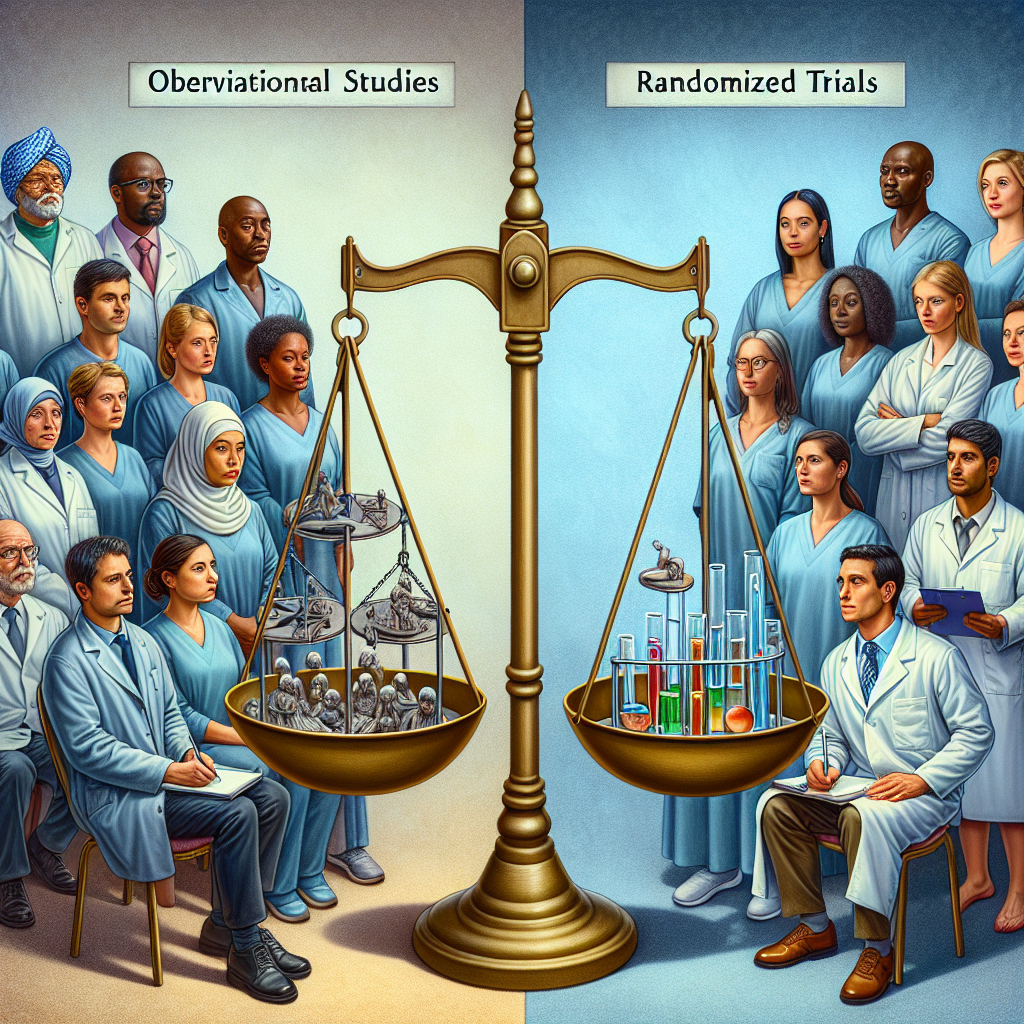
Introduction
In the vast realm of medical research and data analysis, the methodologies employed can pivot the findings in significantly different directions. The cornerstone of evidence-based medicine rests on understanding these methodologies, primarily observational studies and randomized trials. Each approach possesses distinct characteristics, strengths, and weaknesses that can influence outcomes in critical ways. This article dives deep into the topic of Observational Studies vs. Randomized Trials: A Comprehensive Comparison, exploring their intricacies and implications in real-world applications.
The choice between observational studies and randomized trials is not merely academic; it affects clinical decisions, policy-making, and ultimately patient outcomes. As we navigate this essential comparison, you will appreciate the nuances that differentiate these methodologies and their respective roles in shaping scientific knowledge.
Understanding the Basics
Before delving into the nuances of Observational Studies vs. Randomized Trials: A Comprehensive Comparison, it’s crucial to establish foundational definitions for both types of research.
What are Randomized Trials?
Randomized controlled trials (RCTs) are considered the gold standard in research for establishing cause-and-effect relationships. In an RCT, participants are randomly assigned to either the intervention group or the control group. This randomization ensures that the groups are comparable at the outset, thus minimizing confounding variables.
Characteristics of Randomized Trials:
- Randomization: Participants are randomly assigned to treatment or control groups.
- Control Groups: Use of placebos or standard therapies as comparisons.
- Prospective Design: Outcomes are measured going forward from the assignment.
- Internal Validity: High level of control over variables, reducing biases.
What are Observational Studies?
In contrast, observational studies involve researchers observing subjects without interventions. Researchers gather data on what happens in the natural setting without manipulating the study environment. Observational studies can be prospective or retrospective.
Characteristics of Observational Studies:
- No Randomization: Participants are allocated based on existing conditions rather than random choice.
- Data Collection: Researchers collect data about exposure and outcomes as they naturally occur.
- Types of Studies: Includes cohort studies, case-control studies, and cross-sectional studies.
- External Validity: More reflective of real-world situations as they involve fewer controls.
Key Differences: Observational Studies vs. Randomized Trials
Table 1: Key Differences between Observational Studies and Randomized Trials
| Feature | Observational Studies | Randomized Trials |
|---|---|---|
| Design | Non-experimental | Experimental |
| Randomization | None | Yes |
| Control over Variables | Limited | High |
| Cost and Duration | Usually lower cost and quicker | Often more expensive and time-consuming |
| Internal Validity | Moderate to low | High |
| External Validity | High | Moderate to high |
| Types of Evidence | Association | Causation |
Case Studies: Real-World Applications
Case Study 1: The Women’s Health Initiative (WHI)
The WHI was a landmark observational study analyzing the effects of hormone therapy on postmenopausal women. While randomized trials had suggested benefits of hormone replacement therapy, the WHI found that, contrary to expectations, it increased risks of heart disease and cancer. This observational study offered vital insights that spurred a reevaluation of hormone therapy, illustrating the power of observational methods in capturing real-world complexities.
Analysis: The WHI underlines how observational studies can provide critical evidence that randomized trials might overlook, particularly when dealing with long-term health outcomes.
Case Study 2: The Diabetes Control and Complications Trial (DCCT)
In contrast, the DCCT stands as a classic example of a randomized trial demonstrating the effectiveness of intensive glucose control in patients with type 1 diabetes. The findings showed significant reductions in diabetes-related complications, solidifying the role of RCTs in confirming causal relationships.
Analysis: The clear and controlled nature of the DCCT strengthens the argument for randomized trials, showcasing their efficacy in establishing causal mechanisms in clinical settings.
Strengths and Limitations
Strengths of Randomized Trials
- Bias Reduction: Randomization helps balance known and unknown confounding factors.
- Causality: Stronger ability to infer cause-and-effect relationships.
- High Internal Validity: Effective in establishing clear, reliable evidence.
Limitations of Randomized Trials
- Ethical Concerns: Can be unethical if withholding treatment that is known to work.
- Cost: Often expensive and time-consuming to conduct.
- Generalizability: Results might not apply to broader populations due to highly controlled conditions.
Strengths of Observational Studies
- Real-World Relevance: More reflective of real-life scenarios and diverse populations.
- Cost-Effectiveness: Generally less expensive and quicker to conduct.
- Ethical Flexibility: Can address questions where RCTs may not be feasible.
Limitations of Observational Studies
- Confounding Variables: Higher risk of bias due to unmeasured confounders.
- Temporal Ambiguity: Difficult to establish a clear cause-and-effect relationship.
- Lower Internal Validity: Findings may be less reliable due to inherent biases.
Choosing the Right Approach
When it comes to deciding between observational studies and randomized trials, the context matters. Here are some key considerations for selecting the appropriate methodology:
-
Nature of the Research Question: If the goal is to establish causality, an RCT is often preferable. If researchers want to explore associations, observational studies may suffice.
-
Feasibility and Ethics: For questions concerning long-term effects where withholding treatment is unethical, observational studies offer a practical alternative.
-
Population Considerations: If the target population is heterogeneous, observational studies can capture broader variations that RCTs might miss.
- Financial Resources: Budget constraints can dictate which study design is viable, as RCTs often require significant investment.
The Role of Hybrid Studies
In recent years, hybrid approaches merging observational study designs with elements of randomized trials have been gaining traction. One effective example is the pragmatic trial. These trials maintain some features of randomization while allowing for more real-world applicability. They help bridge the gap between the rigor of RCTs and the relevance of observational studies, offering a distinctive middle path.
Conclusion
This comprehensive comparison between observational studies and randomized trials underscores the importance of understanding the methodologies that shape medical research. While both approaches have distinct strengths and weaknesses, they also have complementary roles in advancing scientific knowledge and improving patient care.
As stakeholders in the healthcare ecosystem—researchers, clinicians, and policymakers—we must thoughtfully select our research methodologies, ensuring we generate the most meaningful evidence to inform practice and policy.
Actionable Insights
- Rigor in Research: When contemplating research questions, assess the most suitable study design to ensure robust, relevant findings.
- Continuous Learning: Stay informed about the evolving landscapes of research methodologies and their implications for clinical practice.
- Collaboration: Engage interdisciplinary teams to enhance study designs combining the strengths of both observational and randomized approaches.
FAQs
1. Are observational studies less reliable than randomized trials?
Observational studies can be reliable, but they often carry a higher risk of bias and confounding. The choice of study design depends on the research question and context.
2. What are some common types of observational studies?
Common types include cohort studies, case-control studies, and cross-sectional studies.
3. How can confounding be managed in observational studies?
Researchers can use statistical methods to adjust for confounding, or they can design studies to collect data on potential confounders.
4. Are randomized trials always more ethical than observational studies?
Not necessarily. The ethics of a study design depend on context, and some RCTs may withhold beneficial treatments, making observational studies a more ethical choice in certain scenarios.
5. Can observational studies inform practice effectively?
Yes, observational studies contribute significantly to clinical guidelines, especially when RCTs are not feasible or ethical. They provide insights into real-world practices and outcomes.
Through this deep dive into Observational Studies vs. Randomized Trials: A Comprehensive Comparison, it’s evident that both methodologies are essential to the fabric of medical research. Understanding their nuances allows us to make informed choices in our quest for knowledge and better healthcare solutions.
















